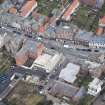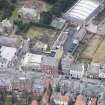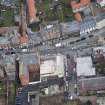Dunbar, 34 High Street
Barracks (First World War), Barracks (19th Century), Flats(S) (20th Century), Inn (18th Century), Retirement Home (20th Century)
Site Name Dunbar, 34 High Street
Classification Barracks (First World War), Barracks (19th Century), Flats(S) (20th Century), Inn (18th Century), Retirement Home (20th Century)
Alternative Name(s) New Inn; Eventide Home; St Andrew's House; St Andrew's Home; New Inn Barracks
Canmore ID 215923
Site Number NT67NE 355
NGR NT 67954 78799
Datum OSGB36 - NGR
Permalink http://canmore.org.uk/site/215923
- Council East Lothian
- Parish Dunbar
- Former Region Lothian
- Former District East Lothian
- Former County East Lothian
Dunbar, New Inn Cavalry Barracks is depicted on the Ordnance Survey 2nd Edition map (Haddingtonshire, sheet VII.9, 1907). The barracks was clearly still in existence in 1929, when a plan was prepared (SRO 'Map, castle Park Barracks and New Inn Barracks. Skeleton record Plan B18/20/32).
It is not known what the building was used for in 1914. The main building, formerly, The New Inn, still stands and the War Office boundary stones are clearly visible.
Modern satellite photography suggests that parts of the western portion of the structure may survive.
Information from HS/RCAHMS World War One Audit Project (GJB) 12 September 2013.
NT67NE 355 c. 679 788
34 High Street, Dunbar has recently been used as a retirement home. It was formerly the New Inn. Information from RCAHMS (LKFJ), May 2002.
Publication Account (2006)
The New Inn was built towards the end of the century by the Earl of Lauderdale, in competition to the St George Hotel. It has a Roman Doric porch and still existing side archway giving access to a coach-house. The New Inn is merely one of several Georgian buildings in High Street, one of the most notable being nos 58--60, with an impressive frontage and a pair of bull's-eye lights.
The Duke of Rutland was also impressed when he arrived in Dunbar to stay at the New Inn; it was here that the army officers billeted in Dunbar had their quarters. He was 'ushered into a spacious room, where ... a ball [was] held once a week, under the patronage of Sir James Stewart who commands an encampment in the neighbourhood'.
Information from ‘The Scottish Burgh Survey, Historic Dunbar: Archaeology and Development’, (2006).
Project (March 2013 - September 2013)
A project to characterise the quantity and quality of the Scottish resource of known surviving remains of the First World War. Carried out in partnership between Historic Scotland and RCAHMS.
















